Bernard Instone (1891—1987) is a highly regarded and very collectable jeweller, designer and silversmith of the later British Arts and Crafts movement. I am delighted and very fortunate to have a rare Bernard Instone ring for sale in my Etsy shop.
Instone was born in Kings Norton in Birmingham, and his artistic talent was apparent from a very early age. He was only twelve years old when he won a scholarship to the Birmingham School of Jewellery at Vittoria Street, part of the Birmingham School of Art, where he studied under renowned Arts and Crafts jeweller Arthur Gaskin and learned silversmithing from 1904—1912.
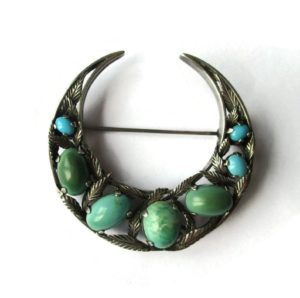
Bernard Instone turquoise crescent brooch, late English Arts and Crafts jewellery. For sale in my Etsy shop, Inglenookery: click on photo for details.
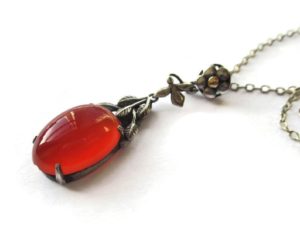
Carnelian, sterling silver and 9 carat gold pendant by Bernard Instone. For sale in my Etsy shop, Inglenookery: click on photo for details.
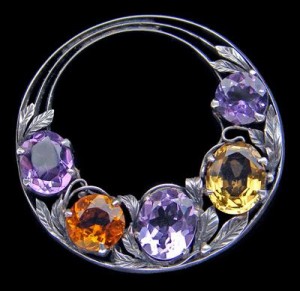
Bernard Instone. Arts and Crafts brooch. Silver, amethyst and citrine. Diameter: 4.1 cm (1.6 in). English, c. 1930. Sold by Tadema Gallery. Note the hand-tooled narrow silver leaves, so characteristic of his work.
After leaving the School, Instone worked for a while for another renowned jeweller and craftsman, John Paul Cooper, in his Westerham studio, and then studied in Berlin under Emil Lettre, Kaiser Wilhelm II’s Court goldsmith. In October 1913 he was back in England, and began part-time teaching at Vittoria Street. As well as making pieces for the Gaskins and Bernard Cuzner and other teachers at the school, he also made his first commissions at this time. In 1920 he set up his own jewellers and silversmith works—Langstone Silver Works—in Digbeth in Birmingham. The company worked from there until 1954 when it moved to Lode Lane in Solihull.
As well as making his own designs, Instone produced jewellery for other jewellers, such as Sibyl Dunlop: a family website about Instone records “he visited [Dunlop] every Friday at her shop in Kensington, supplying her with made up designs already marked up with the SD mark ready for the retail market and [in the] 1940s Liberty became a customer after 25 years of trying to sell to them.” His two sons came to work in the business, and Instone retired in 1963 to the Cotswolds, where he died in 1987.
Instone was strongly inspired by nature, and floral themes occur in most of his pieces. His jewellery can be roughly divided into two types: that with enamel, and that without.
His finest and showiest pieces belong to the latter category: fantastic brooches, rings, necklaces, bracelets, dress clips and earrings with semi-precious stones and sometimes pearls in intricate silver mounts, often with detailed hand-tooled foliage and scrolls. One of his trademark designs are long, fine handmade silver leaves with hand-tooled veins. His favourite stones to use were citrines and amethysts.
The enamel pieces commonly have a floral theme, with leaves and multicoloured flowers often in sugary pastel colours, all picked out in enamel and sometime embellished with marcasites.
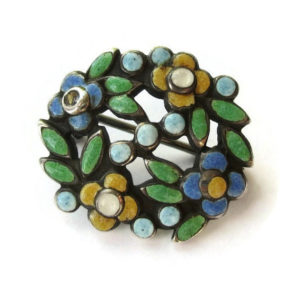
Another Bernard Instone enamel brooch in a different colourway. For sale in my Etsy shop: click on link for details.
Instone sometimes signed his work ‘BI’ and ‘SILVER’, but just as often did not sign his work at all. His style is so distinctive it is easy to spot an Instone once you have got your eye in, though! (I recently saw a fabulous Instone silver and amethyst crescent brooch on eBay which was described by the seller as Victorian. It positively screams Instone! Sadly my pockets weren’t deep enough to buy it.)
Instone’s pieces were very popular during his lifetime and have become increasingly collectable. His work is held in the collections of the Victoria & Albert Museum in London, and is sold by London galleries such as Van Den Bosch and Tadema Gallery: the Instone jewellery in the archive sections of their websites is well worth a look.
I am so happy to be able to offer a rare Bernard Instone moonstone and silver ring in my Etsy shop. A near-identical ring was sold by Tadema Gallery (photos here, scroll down a bit and here, in high resolution). The ring has Instone’s famous handmade silver leaves on either side of the stone. It dates from c. 1930.
Click on the following photos to enlarge:
Okay I went a bit mad with the photos, but Etsy only allows you five and it is so pretty I wanted to show it off properly!
Update February 2015: The ring has now sold. Sorry!
UPDATE July 2016: I briefly had a rare early Bernard Instone brooch for sale in my Etsy shop, but it sold in under 24 hours. Sorry!
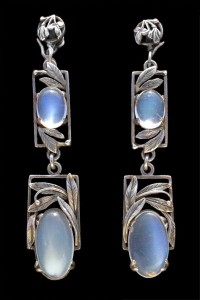


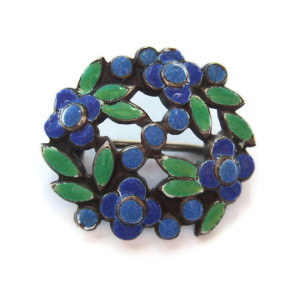
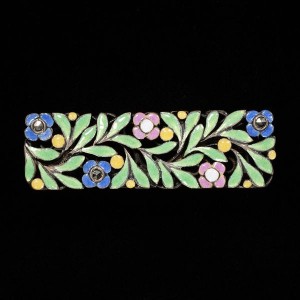
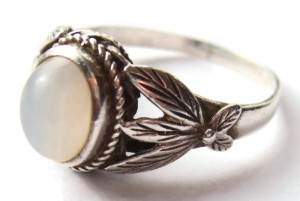
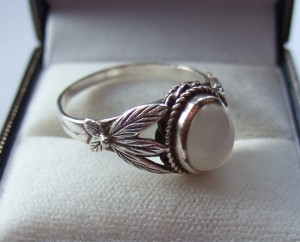
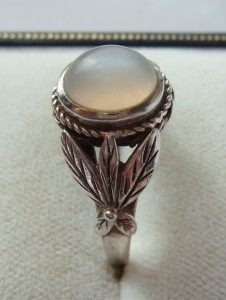
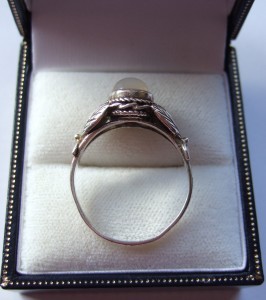
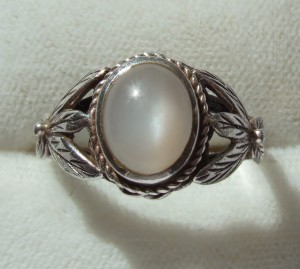
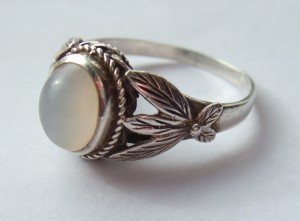
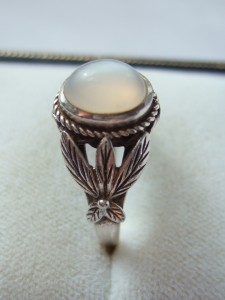
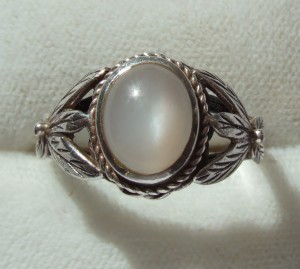
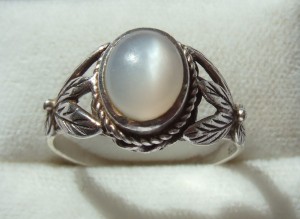
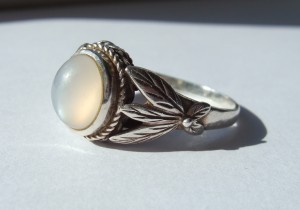
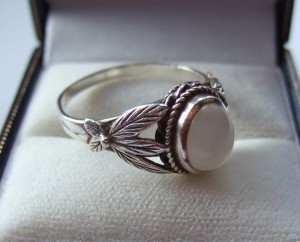
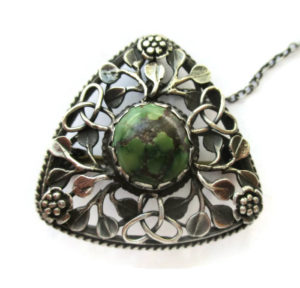
I am very interested in a ring which I brought several years ago. It is 18 carat as a black oval opal and diamonds around the outside they are set in platinum. In side the ring it has marked Bernard Instone, is full name, I was under the impression he usually marked his jewellery with B I. I would really like to know more about the ring, I had it valued but the jeweller didn’t take in to consideration the maker as he knew nothing about the him, he only valued the ring on its contents. If you need a photo please let me know.
Many kind Regards
JP (edited by Inglenookery for privacy)
Hi JP,
Your ring sounds very unusual – Instone normally worked in silver, and occasionally gold, rather than platinum, and I can’t think of a ring of his I’ve seen with diamonds – usually he stuck to semi precious stones (I must stress I am no expert – just a very interested amateur). So it sounds like a very special ring. There are records of him stamping his full name in a handwriting-like script on some articles, as in this thread with a photo: http://www.silver-collector.com/topic1066.html Does yours look like that? Again, normally rings (because of their size) just have the B.I stamp (if they are signed at all), so the fact that yours is signed in an unusual manner again suggests the ring is something out of the usual. He undertook many commissions, so maybe this was one for a very wealthy client. I definitely think you should get it valued again by a jeweller who is familiar with his work, if only to get the correct value for insurance purposes. I think you might be pleasantly surprised!
Another way to go is to put a few photos up on the Collectors Weekly board with your query (post on the Show & Tell section of the Arts and Crafts part of the site: http://www.collectorsweekly.com/fine-jewelry/arts-and-crafts/stories. There are many very knowledgeable readers/collectors who can give information (and I’m sure would love to see your ring too!) Good luck!
Hello thank you for your information. The script is the same as on the website you gave me, it also has plat and hallmarks inside the ring. I shall let you know what I find out. Yet again thanks
Many kind regards
Jean
Hi, I have had a respond on the website you advised me to use. I have conflicting views, one says this is quite rare piece a late piece and he as never seen Instone use either Gold or Diamonds. Another says it it’s Art Deco. Watch this spot.
I’ve had a look at your photos and I totally agree with Jewels1900 – it looks like a later period Instone piece, rather than an Arts and Crafts one. It’s lovely and the signature is great to see. You’re very lucky! Hopefully you’ll get more comments about it. Given that Instone retired in 1963 that probably gives you a terminus ante quem for the piece (I’m not sure if his sons carried on in his name – more research to be done!). Have you worked out the year from the hallmark? It might be worth looking at some of the Sibyl Dunlop jewellery too, just out of interest, as he made a lot of her designs for her and you might see some similarities – I wonder if, given their close working relationship, they might have influenced each other to some degree?
Thank you for your in put. I’ll try and research with the information you have given me. If you can help me in any way, I would be most grateful.
Thank you
Jean
Glad to help – it was great to see your photos on the Collectors Weekly website, so thank you too!
One other thought – the family website I mentioned above has some sketches of Instone’s – so it might be that there is a family archive of his designs. It might be worth trying to contact the person who made the webpages. (http://www.allen-family-tree.co.uk/bernard-instone.html, http://www.allen-family-tree.co.uk/bernard2.html and http://www.allen-family-tree.co.uk/bernard3.html. Just a thought.
Good news, I managed to get in contact with a very nice family member, she is also very interested in the ring, she is sending the photos to another family member who as some sketches of his work, fingers crossed this ring might be amongst them. Apparently Bernard loved to sketch. Another interesting thing is that she thinks it’s a early piece because he only used his full signature in his earlier years. When he set up his work shop he used B.I. Hope to keep you informed. Yet again thank you for your help.
Jean
Hi Jean
Oh how exciting! Let’s hope the sketches come up with the goods. Stylistically it doesn’t look like an earlier piece to me – it’s not at all ‘Arts and Craftsy’. So maybe he used the signature for special pieces all through his career? I can’t see it as an early piece of his at all – it doesn’t sit with all the other things he was producing then. I’m guessing 1950s from the look of it – but I am strictly an amateur about these things. By the way – if you ever decide to sell it at auction, do please let me know (not that I can afford to buy it, but I’d love to see the catalogue entry and see how much it goes for!) As the family seemingly has such a fantastic archive – maybe you could suggest to the lady you spoke to that someone could use it to write a book about Instone? I think there’s a need for one!
Apparently there are books and all sorts of things the family have, but haven’t got around to cataloging it. Also it would need a army operation to get the items together, from the sounds of it there all over the country. Bernard Instone was one of nine boys. Meaning they haven’t written a book, but Instone was very good at writing down in books and alway carried pencil and paper where ever he went.
Wow, sounds like a fantastic project for a researcher/writer looking for a jewellery topic! I’m sure a book on Instone would sell like hot cakes, he’s so popular.
Maybe it could be a project for you. You do seem very keen on Mr Instones work.
Ah Jean, what a lovely idea but sadly I have too many other research projects on at the moment competing for my time to take another one on! These short pieces for the blog are about as much as I can spare the time for. Maybe someone else will read about the Instone archive and pick up the baton though. Here’s hoping!
Well I will mention it to her when I get a reply. She was having a problem with her computer, so hadn’t seen the photos. Do you really think people would be interested, as she is a family member, she may not realise that many people care, sometimes it happens like that.
Gosh, absolutely. Given how popular he is, I’m surprised no-one’s written a book on him and his work yet. The illustrations would be stunning if permission could be got to reproduce all the photos of his work that crop up on the web – or even better, track down the pieces and re-photograph them in studio conditions. Elyse Zorn Karlin wrote a little bit about Instone in her 1993 book, just half a page or so, and she used some of the Tadema Gallery photos to illustrate it; he’s been written about in several other books but never at length. Given that his work is now being faked (just the other week there was a fake pair of his earrings on eBay), that’s a sign that he’s increasingly popular!
Please, please, please, Jean, could you ask her to make sure no-one in her family mislays or chucks out any of the archive, as it is priceless and irreplaceable and such a boon to researchers. (And as someone who spends a lot of time working in museum and record office archives, I can heartily recommend considering perhaps donating all the material to a museum – maybe the Birmingham one – where they would be looked after in archival conditions, catalogued, possibly digitally reproduced so there are records online, and the archive would be physically and digitally available to researchers permanently. However, I know these will be treasured family mementos, so that’s not a decision easily taken. It would guarantee their safe future, though.)
If I didn’t have so many other research projects on the boil, I would certainly give this one serious thought. Instone is such an amazing jeweller. And that way I’d get to see some of his beauties too, rather than just drool over the photos!
Sorry about the grammar and spelling mistakes above. I have had a couple of beers.
Hi Jean,
As she has a computer (albeit not working at the moment), rather than mucking about with emails, the best way is to include the link to the comments section of this page: https://www.inglenookery.com/?p=164#comments That way she can see them all in order and set out nicely. (I have omitted your last comment because it has personal information in it). Hope that’s okay!
Yes of course, lol.
I’ve sent your website address to her.
Thanks
Jean
Did you get anywhere with the hallmark on the ring, Jean? That would give you the year it was assayed – and assaying is normally done soon after manufacture so gives a pretty good idea of its actual age.
Hi I’ve had another look through my scrappy lope. First is PLAT then It could be 18 then there is another symbol I thought it was CT as in carat, now I’m not so sure. Could you think of something. Then of course is name. Usually I can see the assay symbol on my other Jewellery, with I can’t. May be he didn’t have it assayed, just a thought.
It’s bold lettering PLAT 18CT then is full name in script. No assay symbols.
I have sent a email to the Birmingham assay office, asking for information. In this piece It wasn’t assayed. May be it wasn’t important to the client and to his self, he seemed a very strong man, that didn’t care about the establishment. What can you say about him he was a man to be admired. Yet may be I might be completely wrong.
I’ve received a email from the Birmingham assays office. Could it be possible to send a email to you, I think you would be very interested in his reply.
Jean
At this moment in time, I feel I’m on a wild goose chase. Nobody has got back to me, is this a good, or is it bad, or I couldn’t care less thing. Do you think I’m wasting my time. I would have thought somebody would have got back to me, I afraid I hate waiting.
Hi Jean
Give it time! Researching anything is always a waiting game, I’m afraid. People are busy and can’t always respond straight away; others won’t reply at all. It’s just the way it goes. Have patience though, and perhaps send out reminder emails in a few weeks if you still haven’t heard anything. If you still don’t get a reply, I’d give that particular avenue up and move on to another. Thanks for you info from the assay office – it sounds like you have an ally there. He might well have other contacts if you want to take it further.
Thanks, sometimes that’s my problem I hate the waiting game, your correct I have to be more patient. I will not give up, I’ll probably ring Craig up in a week or 2 and follow up on Bernard Instones granddaughter. What ever happens I’ll keep you informed.
Hi
I’ve just been in contact with Craig at the Birmingham assay office. He says the ring was from either the 1920s or 30, so that would make it a early piece. He was saying if you look at his Silver spoons of that era he uses the same way of signing. He only use this way of signing in his early years. Bernard didn’t have to hallmark the ring because there was stone in it. When I’m back in the UK I’ll send it down to them to look at it. He said it was a commission piece. So next I’ll have to see if I can get any where with his Granddaughter. Just thought you would be interested.
That’s interesting about the hallmarking. I deal overwhelmingly with silver and occasionally pewter and copper alloy jewellery and know precisely diddly squat about how the gold hallmarking system works. I didn’t realise the presence of a stone meant that hallmarking was unnecessary. Another learning experience for me. Love it!
I’ve rung Bernard’s Granddaughter. I told her what Craig had said. She also told me that Bernard in his early work signed his jewellery in this way, then stopped. It was his sons who in later years use the same signings in the bespoke jewellery. She has given me her uncles number who used to work in the business, he’s 90, she said he might or might not talk to you, fingers crossed.
Hi Jean
That’s all very exciting indeed. Thanks for letting me know. It sounds like you have well and truly got the researching bug – now you just need to write that book! I still get the feeling that it is a later ring, going on purely stylistic grounds, but what do I know? Just an interested very amateur! It’s interesting that the sons continued on after he had retired – I had wondered if they did but didn’t know for sure. If you could talk to her uncle (is he one of Bernard’s sons?) that would be fantastic. Let’s hope he’s happy to talk! Do keep me posted – I’m loving this!! Thanks for keeping me posted – I appreciate it.
I’m not sure if the brothers made jewellery. John was a sales man for the company and Paul (who is the son of Bernard) was the manager. If you look at the website you gave me, it says that the brothers fell out during the 1960s. On the website of Paul Bernard Lewis Instone, for his occupation it says Jeweller. Can’t found anything for John.
I am a specialist in jewellery and consider the ring is a late piece, in terms of style, production technique, and the cut of the diamonds. I think the opal is a doublet which is also consistent with pieces by Bernard Instone and other Arts and Crafts jewellers. There are many examples of his work mounted with black opal doublets.
Ah thanks Dave – that’s great to know. I will try to get in touch with Jean and let her know, just in case she doesn’t see this here. Thanks again!
Hi Dave, thanks for your information. I’m a little confused, as you see from Craigs answer in one of the post above, he works at the Birmingham assays office. He has said that he only used this type of signiture on his earlier work, especially spoons.
I know when his sons took over, Ive bought some of Instone’s later work they are marked B.I, do you know if he or is sons use the full signature in his later work.
I Will be interested in your reply. I do agree people have said this ring is later, also other people have said its a earlier piece. A mystery.